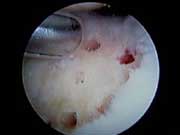Surgical Alternatives To Knee Replacement
These surgical alternatives to knee replacement are performed with the goal of helping the knee to heal itself.
These surgical procedures can be done by themselves or in combination depending on the specific problems of the patient's knee.
Microfracture
 Microfracture consists of arthroscopically creating small holes in the knee joint articular surfaces where full-thickness cartilage defects exist. The purpose of the procedure is to allow pluripotential marrow cells to get into the joint to regenerate a new fibrocartilaginous coating. The procedure is short and performed on an outpatient basis. It is necessary to use crutches for ambulation for six to eight weeks after the procedure. Only 35 lbs. of weight may be borne on the affected extremity during this time. Our in house results show that at least 80% of patients are substantially improved.
Microfracture consists of arthroscopically creating small holes in the knee joint articular surfaces where full-thickness cartilage defects exist. The purpose of the procedure is to allow pluripotential marrow cells to get into the joint to regenerate a new fibrocartilaginous coating. The procedure is short and performed on an outpatient basis. It is necessary to use crutches for ambulation for six to eight weeks after the procedure. Only 35 lbs. of weight may be borne on the affected extremity during this time. Our in house results show that at least 80% of patients are substantially improved.
Go to our microfracture page to learn more .
High Tibial Osteotomy (HTO)
 High tibial osteotomy consists of cutting the tibia and straightening it. This procedure is can be done outpatient or with a 23 hour observation stay at the hospital. Pins are inserted in the knee and an external fixation device is worn for 2-3 months. After this time the pins are removed. The idea is to shift weight away from the diseased medial compartment and onto the more normal lateral compartment. The decrease in pressure results in cartilage regeneration in and of itself in many patients. However, HTO is combined with microfracture in most cases to provide even greater cartilage regeneration. The procedure is effective in most patients for a period of at least several years. In some patients benefits may last as long as 20 years.
High tibial osteotomy consists of cutting the tibia and straightening it. This procedure is can be done outpatient or with a 23 hour observation stay at the hospital. Pins are inserted in the knee and an external fixation device is worn for 2-3 months. After this time the pins are removed. The idea is to shift weight away from the diseased medial compartment and onto the more normal lateral compartment. The decrease in pressure results in cartilage regeneration in and of itself in many patients. However, HTO is combined with microfracture in most cases to provide even greater cartilage regeneration. The procedure is effective in most patients for a period of at least several years. In some patients benefits may last as long as 20 years.
High tibial osteotomy is a good option for patients under 60 years of age. It becomes even more attractive for progressively younger patients because it “burns no bridges”; it can be converted to a knee replacement if it fails. High tibial osteotomy permits a wide range of work and recreational activities, without fear of damaging or wearing out a knee replacement.
For patients with lateral compartment arthritis, a similar procedure called distal femoral osteotomy (DFO) may be performed instead.
Go to our High Tibial Osteotomy page to learn more.
Autologous Chondrocyte Implantation (ACI)
The coating in joints that allows them to glide freely and painlessly is hyaline articular cartilage. When defects develop in it, bone is exposed and pain results. These holes can now be filled by taking a tiny biopsy from the knee of the patient’s own articular cartilage. It is flown to the Genzyme biosurgery lab in Boston and grown in tissue culture. It is then flown back and implanted in the knee under a biologic patch. The cells take root and grow. Patients must be touch-down weight bearing for six weeks and then partial weight bearing for six weeks. After this time they may walk normally. Complete healing takes nine to twelve months. The procedure is FDA approved, reimbursed by all major insurance carriers, and success rates are in the 85-90% range.
This is an excellent option for suitable patients. Excellent results have been achieved in patients as old as 55 and as young as 15.
Go to our ACI page to learn more .
Unicompartamental Knee Arthroplasty (UKA)
Unicompartmental knee arthooplasty is when one of the knee’s tibio-femoral compartments, usually the medial one, is resurfaced. Compared to a full knee replacement (TKA), this procedure has a faster recovery time and less postoperative pain. Patients usually feel that their knee movement is more natural with a UKA than with a TKA. If the UKA wears out, it can be replaced with a standard total knee replacement.
Go to our UKA page to learn more.